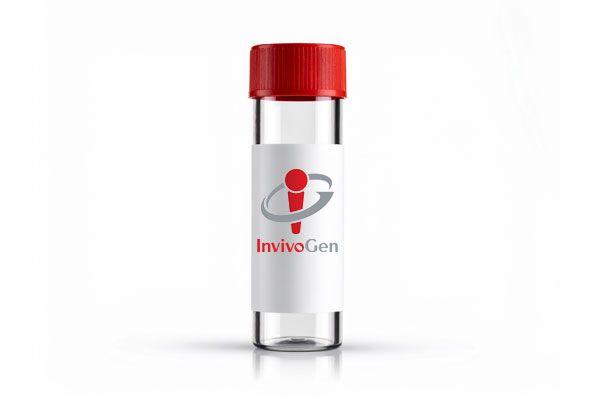B16-Blue™ IFN-γ Cells
-
Cat.code:
bb-ifng
- Documents
ABOUT
Murine Type II IFN Reporter Cells
B16-Blue™ IFN-γ cells are designed to monitor mouse type II interferon IFN-γ-induced JAK/STAT1 stimulation or inhibition through SEAP activation. This colorimetric cytokine bioassay can be used to screen activatory or inhibitory molecules, such as engineered cytokines and neutralizing antibodies, respectively.
Mouse IFN-γ reporter cells respond specifically to mouse (m) IFN-γ (see figures). They do not respond to human (h) IFN-γ or mIFN-α/β.
Key features
- Readily assessable STAT1-inducible SEAP reporter activity
- Convenient readout using QUANTI-Blue™ Solution
- No response to human IFN-γ
- No response to type I IFNs (e.g. IFN-α/β)
Applications
- Therapeutic development
- Drug screening
- Release assay
IFN-γ is a pleiotropic cytokine with anti-viral, anti-tumor, and immunomodulatory functions.
Disclaimer: These cells are for internal research use only and are covered by a Limited Use License (See Terms and Conditions). Additional rights may be available.
SPECIFICATIONS
Specifications
IFN-γ
Mouse
Detection of mouse IFN-γ
0.1 ng - 1 µg/ml
Complete DMEM (see TDS)
Verified using Plasmotest™
Each lot is functionally tested and validated.
CONTENTS
Contents
-
Product:B16-Blue™ IFN-γ Cells
-
Cat code:bb-ifng
-
Quantity:3-7 x 10^6 cells
- 1 ml of Zeocin® (100 mg/ml)
- 1 ml of Normocin™ (50 mg/ml)
- 1 ml of QB reagent and 1 ml of QB buffer (sufficient to prepare 100 ml of QUANTI-Blue™ Solution, a SEAP detection reagent)
Shipping & Storage
- Shipping method: Dry ice
- Liquid nitrogen vapor
- Upon receipt, store immediately in liquid nitrogen vapor. Do not store cell vials at -80°C.
Storage:
Caution:
Details
Cell line description
B16-Blue™ IFN-γ cells were generated from the murine B16 melanoma cell line by the stable transfection with the secreted embryonic alkaline phosphatase (SEAP) reporter under the control of the ISG54 promoter. This promoter comprises IFN-stimulated response elements (ISRE) that are recognized by the ISGF3 complex. The binding of IFN-γ to its receptor triggers a signaling cascade leading to the activation of STAT1 and the subsequent production of SEAP. This can be readily assessed in the supernatant using QUANTI-Blue™ Solution, a SEAP detection reagent.
Interferon-gamma background
Interferon-gamma (IFN-γ) is the sole member of the type II IFN family. It is secreted from CD4+ Th1 cells and activated NK cells. It plays a role in activating lymphocytes to enhance anti-microbial and anti-tumor effects [1-]. In addition, it plays a role in regulating the proliferation, differentiation, and response of lymphocyte subsets.
IFN-γ exerts its action by first binding to a heterodimeric receptor consisting of two chains, IFNGR1 and IFNGR2, causing its dimerization and the activation of specific Janus family kinases (JAK1 and JAK2) [4, 5]. Two STAT1 molecules then associate with this ligand-activated receptor complex and are activated by phosphorylation. Activated STAT1 molecules form homodimers and are translocated to the nucleus, where they bind IFN-stimulated response elements (ISRE) in the promoter of IFN-inducible genes.
1. Ivashkiv L.B., 2018. IFNγ: signalling, epigenetics and roles in immunity, metabolism, disease and cancer immunotherapy. Nat Rev Immunol. 18(9):545-558.
2. Shtrichman R. & Samuel CE., 2001. The role of gamma interferon in antimicrobial immunity. Curr Opin Microbiol. 4(3):251-9.
3. Sato A. et al., 2006. Antitumor activity of IFN-lambda in murine tumor models. J Immunol. 176(12):7686-94.
4. Platanias L.C., 2005. Mechanisms of type-I- and type-II-interferon-mediated signalling. Nat Rev Immunol. 5(5):375-86.
5. Schroder K. et al., 2004. Interferon-gamma: an overview of signals, mechanisms, and functions. J Leukoc Biol. 75(2):163-89.
DOCUMENTS
Documents
Technical Data Sheet
Safety Data Sheet
Validation Data Sheet
Certificate of analysis
Need a CoA ?






